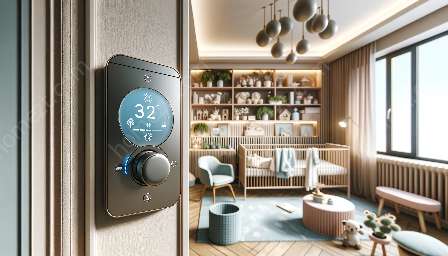Ensuring thermal comfort in a nursery and playroom is essential for the well-being of children. In this topic cluster, we will explore the significance of thermal comfort, strategies for temperature control, and its implications in nursery and playroom settings.
The Significance of Thermal Comfort
Thermal comfort refers to a state of mind in which a person feels satisfied with the thermal environment. In nursery and playroom environments, maintaining optimal thermal comfort is crucial for children's health, safety, and overall well-being.
Impact on Children's Health
Children are more sensitive to temperature variations compared to adults. Inadequate thermal comfort can lead to discomfort, irritability, and even health issues such as respiratory problems and allergies. Maintaining a comfortable temperature in the nursery and playroom is paramount to promote the health and development of children.
Importance of Temperature Control
Controlling the temperature in the nursery and playroom is essential to create a cozy and safe environment for children. Proper temperature regulation can enhance their mood, concentration, and overall sense of well-being. Additionally, it can contribute to better sleep quality, which is vital for children's growth and development.
Strategies for Nursery Temperature Control
- Optimal Temperature Settings: The recommended temperature range for nursery and playroom environments is between 68°F and 72°F to ensure optimal thermal comfort.
- Use of Thermostats: Installing a programmable thermostat allows for precise temperature control, ensuring that the environment remains comfortable throughout the day.
- Proper Insulation: Ensuring proper insulation in the nursery and playroom helps maintain consistent temperature levels and reduces energy consumption.
- Natural Ventilation: Allowing for natural ventilation by opening windows or using ceiling fans can help regulate the temperature and freshen the air in the nursery and playroom.
Implications in Nursery & Playroom Environments
Creating thermal comfort in the nursery and playroom goes beyond temperature control. It also involves considering factors such as humidity, air quality, and air circulation to ensure a holistic approach to thermal comfort.
Humidity Control
Maintaining optimal humidity levels in the nursery and playroom is crucial, as excessively dry or moist air can lead to discomfort and health issues for children.
Air Quality
Ensuring good indoor air quality through proper ventilation, air filtration, and minimizing exposure to pollutants is vital for creating a healthy and comfortable environment for kids.
Comfortable Play Area
Designing a comfortable play area within the nursery involves considering factors such as floor insulation, suitable floor coverings, and adequate air circulation to ensure an inviting and safe space for children.
Conclusion
Creating thermal comfort in the nursery and playroom is essential for promoting the well-being and development of children. By implementing effective temperature control strategies and considering various environmental factors, parents and caregivers can ensure a cozy, safe, and healthy environment for children to thrive.



